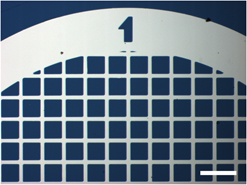Article contents
Photocrosslinking of low band-gap conjugated polymers using alkyl chloride sidechains: Toward high-efficiency, thermally stable polymer solar cells
Published online by Cambridge University Press: 23 April 2018
Abstract

We report the synthesis and photovoltaic characterization of four novel polymers based on poly({4,8-bis[(2-ethylhexyl)oxy]benzo[1,2-b:4,5-b′]dithiophene-2,6-diyl}{3-fluoro-2-[(2-ethylhexyl)carbonyl]thieno[3,4-b]thiophenediyl}) (PTB7) incorporating various numbers of photocrosslinkable n-octyl chloride sidechains (PTB-Cl). These polymers showed similar optoelectronic properties to PTB7 and readily cross-linked in the form of thin films after deep-UV exposure. Photolithography with micrometer-scale patterning is demonstrated. PTB-Cls exhibit similar PV performances to PTB7 and lightly cross-linked PTB-Cls showed stable high photoconversion efficiencies after prolonged thermal treatment. However, it is found that a high-degree cross-linking is needed to prevent the formation of PCBM crystallites at high annealing temperatures even though the PV performance is stabilized with a much lower degree of cross-linking. This implies that the complete prevention of PCBM crystallite formation is not necessary to affect the stabilization of PV devices against excessive heat.
Information
- Type
- Invited Article
- Information
- Journal of Materials Research , Volume 33 , Issue 13: Focus Issue: Stabilization of Organic Electronic Materials and Devices , 14 July 2018 , pp. 1879 - 1890
- Copyright
- Copyright © Materials Research Society 2018
References
REFERENCES
- 9
- Cited by


